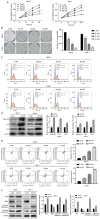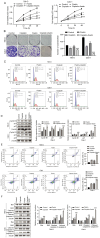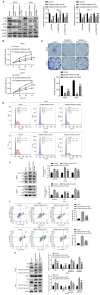Fisetin enhances cisplatin sensitivity in renal cell carcinoma via the CDK6/PI3K/Akt/mTOR signaling pathway
- PMID: 38426151
- PMCID: PMC10902757
- DOI: 10.3892/ol.2024.14298
Fisetin enhances cisplatin sensitivity in renal cell carcinoma via the CDK6/PI3K/Akt/mTOR signaling pathway
Abstract
Cisplatin resistance is ubiquitous among patients with renal cell carcinoma (RCC). The present study assessed the role of fisetin in regulating cisplatin sensitivity and increasing the efficacy of chemotherapy for patients with RCC. Cell Counting Kit-8 and colony formation assays were used to assess the proliferation of RCC cells after fisetin and cisplatin treatment. The mRNA expression levels of cyclin-dependent kinase (CDK)6 were evaluated using reverse transcription-quantitative PCR. The expression levels of CDK6 and key proteins of the PI3K/Akt/mTOR signaling pathway were assessed using western blotting. The present study demonstrated that fisetin inhibited the proliferation and colony-forming ability of RCC cells, and induced apoptosis and cell cycle arrest in a dose-dependent manner. Additionally, fisetin enhanced the antineoplastic effects of cisplatin, as demonstrated by the increase in proliferation inhibition and apoptosis promotion after fisetin and cisplatin combination treatment. Furthermore, fisetin regulated the PI3K/Akt/mTOR signaling pathway through CDK6 inhibition, which enhanced cisplatin sensitivity. Overexpression of CDK6 neutralized the positive effects of fisetin on the improvement of cisplatin sensitivity in RCC cells. In conclusion, fisetin may enhance the sensitivity of RCC cells to cisplatin via the CDK6/PI3K/Akt/mTOR signaling pathway.
Keywords: cisplatin; drug resistance; fisetin; renal cell carcinoma.
Copyright: © Jiang et al.
Conflict of interest statement
The authors declare that they have no competing interests.
Figures




Similar articles
-
Fisetin inhibits laryngeal carcinoma through regulation of AKT/NF-κB/mTOR and ERK1/2 signaling pathways.Biomed Pharmacother. 2016 Oct;83:1164-1174. doi: 10.1016/j.biopha.2016.08.035. Epub 2016 Aug 20. Biomed Pharmacother. 2016. PMID: 27551764
-
Silencing long non-coding RNA ROR improves sensitivity of non-small-cell lung cancer to cisplatin resistance by inhibiting PI3K/Akt/mTOR signaling pathway.Tumour Biol. 2017 May;39(5):1010428317697568. doi: 10.1177/1010428317697568. Tumour Biol. 2017. PMID: 28459375
-
Inhibition of PI3K/Akt/mTOR signaling pathway alleviates ovarian cancer chemoresistance through reversing epithelial-mesenchymal transition and decreasing cancer stem cell marker expression.BMC Cancer. 2019 Jun 24;19(1):618. doi: 10.1186/s12885-019-5824-9. BMC Cancer. 2019. PMID: 31234823 Free PMC article.
-
Root extract of Hemsleya amabilis Diels suppresses renal cell carcinoma cell growth through inducing apoptosis and G2/M phase arrest via PI3K/AKT signaling pathway.J Ethnopharmacol. 2024 Jan 10;318(Pt B):117014. doi: 10.1016/j.jep.2023.117014. Epub 2023 Aug 7. J Ethnopharmacol. 2024. PMID: 37557938
-
Exploring the therapeutic promise of fisetin: molecular mechanisms and clinical aspects in lung cancer.J Complement Integr Med. 2025 Feb 28. doi: 10.1515/jcim-2024-0444. Online ahead of print. J Complement Integr Med. 2025. PMID: 40013371 Review.
Cited by
-
Natural Compounds in Cancer Therapy: Revealing the Role of Flavonoids in Renal Cell Carcinoma Treatment.Biomolecules. 2025 Apr 25;15(5):620. doi: 10.3390/biom15050620. Biomolecules. 2025. PMID: 40427513 Free PMC article. Review.
References
LinkOut - more resources
Full Text Sources
Miscellaneous
